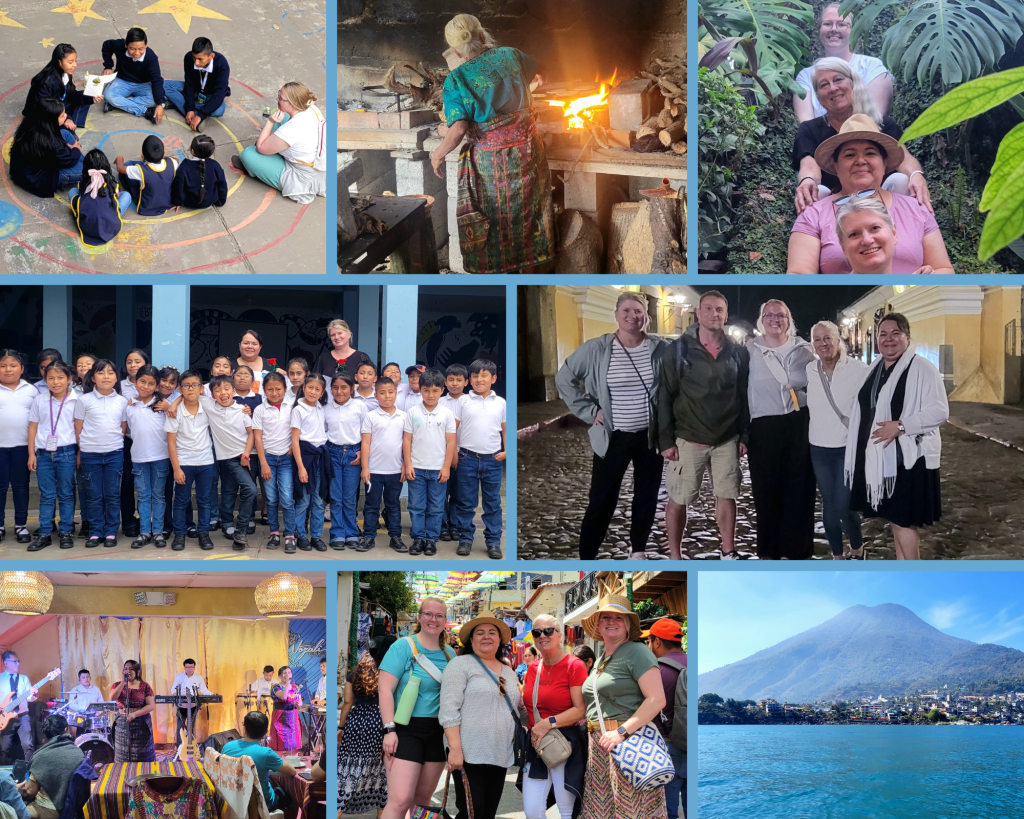Amanda Rink, Editor
When four educators from Clarion-Goldfield-Dows School District packed their bags for spring break, it wasn’t to chase sunshine or relaxation. Instead, they set out on a journey to Antigua, Guatemala, a historical city surrounded by volcanoes, with a mission in mind: to better understand the roots of their immigrant students and the immense culture shift they experience when arriving in rural Iowa.
“It wasn’t a vacation,” said Megan Fiscus, an English Language Learner (ELL) teacher. “It was a true learning experience to be immersed in the culture and language for a solid week. You start to understand how our students feel when they come here and don’t understand what’s going on around them.”
Fiscus traveled alongside 5th-grade reading teacher Maycie Rector, 4th-grade teacher Terri Godby, and Spanish interpreter and ELL paraeducator Daisy Carrillo. Together, they left the States for a “compassionate travel” experience – one that provided cultural, academic, and emotional understanding.
The trip was not funded by the school. Instead, the team fundraised money, including a large donation from Versova Community Foundation, which recognized the importance of supporting the children of its workforce.
Antigua, once the capital of Spanish Central America, is considered one of the safest cities in Guatemala. Despite Antigua’s charm, the country remains one of the poorest in the region, with many families living in rural areas lacking basic necessities like clean water, modern housing, and access to education.
“Seeing it firsthand changes your mind,” said Carrillo. “We visited a private school that only charges $25 to $100 for the school year but families still struggle to pay.”
The group visited classrooms that were a fraction of the size of those in Clarion. Materials were sparse, yet students were self-disciplined and remarkably responsible.
“They all brought their own containers for snacks, brushed their teeth at school, swept floors, cleaned tables, and didn’t leave a mess,” Rector reflected. “There were no reminders, no misbehavior. Life is harder there, and the kids have more life skills from a younger age.”
Teachers in Guatemala earn about $350 a month and often lack formal training. Still, the community fills gaps where it can. Parents work in the schools, often cooking the meals to offset tuition costs. Grandparents walk children to school. There are no clocks in the classrooms, all of these details that the visitors noticed reflect broader cultural values: time isn’t rushed, life is lived slowly, and family is central.
“It made me think about my Guatemalan students here,” shared Godby, who teaches seven students from Guatemala in her 4th-grade class, some of who are working hard at learning the English language. “They’ve come from a place where they have more freedom, more responsibility, and a strong sense of family and community. Coming here, with all the structure, rules, and language barriers, it has to be exhausting for them.”
The trip wasn’t without emotional weight. The teachers found themselves exhausted at the end of the day, from the mental toll of trying to understand everything in a foreign language.
“One day, we had a full day of school visits and then two to three hours of Spanish lessons,” said Godby. “By the end, we were exhausted. But it made us think, this is what our students feel like every day when everything is in a language they don’t fully understand.”
Rector agreed, “Seeing an English menu gave me a sense of relief. It reminded me how powerful it is to give our students materials in their language, to lower that stress, so they can be ready to learn.”
The teachers were left with powerful empathy for immigrant students who face similar challenges when coming to Clarion. But among the challenges they faced during the week from home, there were also moments of pure clarity.
Teachers shared that the classrooms had no tech, only computer labs. “They had Apple desktops in the computer lab, but most of the teaching tools were basic. Still, the kids got straight to work. No questions asked,” Rector said.
The kids cleaned up after themselves and brushed their teeth and face at school after a meal or snack. This was an idea all of the education professionals agreed wouldn’t be a bad one to implement at our schools. The kids also managed themselves without a lot of redirection from the adults around them. The teachers visiting felt the traits were born out of necessity and “just expected”.
One vivid memory came after lunch one day. Children had made a makeshift pool table from cardboard and egg cartons. “It was a reminder that kids don’t need much to play,” said Fiscus. “They were laughing, playing games, using pencils and straws as cue sticks. They had less, but they also had more.”
Beyond the classroom, the teachers encountered a reality that many immigrant students rarely discuss: danger. In many areas of Guatemala, education is only free through sixth grade. After that, families must pay, and safety concerns often force older students, especially girls, to drop out.
“At a certain age, some girls just stop going,” Fiscus said.
Carrillo shared insight from a student she teaches in Clarion, “It becomes unsafe for them to walk to school, especially if their commute is long or isolated. One of our high school students explained that’s part of why their family left, it just wasn’t safe anymore.” It isn’t just girls who feel unsafe, boys often stay close to home to avoid being recruited into gangs.
This awareness hit the teachers hard. “It’s not just that they’re coming here for something better — they’re also leaving because they can’t stay,” Carrillo added. “They don’t always have a choice.”
Though the contrast between life in Guatemala and rural Iowa might seem striking, the teachers left with a deep admiration for both.
“They may come here for better opportunities, for education, healthcare, and safety, but they’re also leaving behind something beautiful,” Fiscus reflected. “It’s a culture rich in tradition, slower living, and tight-knit family.”
Although they could recognize the beautiful culture and life their students and their families may be leaving behind, the group was happy to be back in Iowa. The educators hope to visit a public school in Guatemala soon, believing that it will better reflect the circumstances where the majority of our students come from.
In the end, the trip reinforced a simple truth, understanding leads to compassion. And compassion can shape a better classroom, which leads to a rich community.


